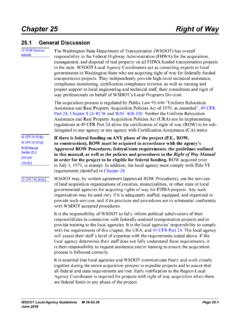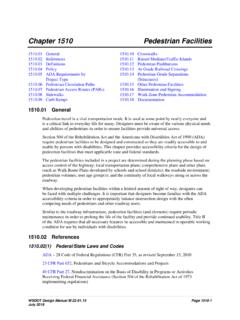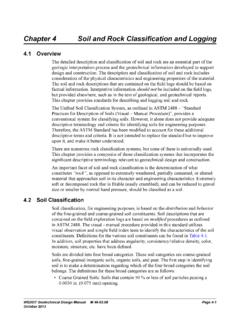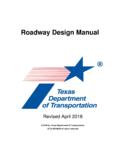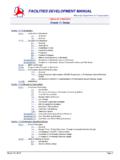Transcription of Chapter 1600 Roadside Safety
1 Chapter 1600 Roadside Safety General Clear Zone Mitigation Guidance Medians Other Roadside Safety Features Documentation References General Roadside Safety addresses the area outside the roadway and is an important component of total highway design . There are numerous reasons why a vehicle leaves the roadway, including driver error and behaviors. Regardless of the reason, a Roadside design can reduce the severity and subsequent consequences of a Roadside encroachment. From a crash reduction and severity perspective, the ideal highway has roadsides and median areas that are relatively flat and unobstructed by objects. It is also recognized that different facilities have different needs and considerations, and these issues are considered in any final design .
2 It is not possible to provide a clear zone free of objects at all locations and under all circumstances. The engineer faces many tradeoffs in design decision-making, balancing needs of the environment, right of way, and various modes of transportation. The fact that recommended design values related to the installation of guardrail and other mitigative actions are presented in this Chapter does not require the WSDOT to modify or upgrade locations to meet current criteria. Roadside Safety may be addressed by projects identified through priority programming, during certain preservation project activities (See Chapter 1120), or may be considered by projects as part of a Safety analysis (See Chapter 321).
3 Elements such as sideslopes, fixed objects, and water are all features that a vehicle might encounter when it leaves the roadway and become part of such an analysis. On projects where the need for mitigation is determined, consider the following mitigative measures (in order of priority): 1. Remove 2. Redesign (a fixed object) so it can be traversable (See Section (2)). 3. Relocate 4. Reduce impact severity (using breakaway features or making it traversable). 5. Shield with a traffic barrier; or 6. Delineate (if the previous options are not appropriate or feasible). Factors for selecting a mitigative measure include, but may not be limited to: Cost (initial and life cycle costs). Maintenance needs Crash severity potential WSDOT design Manual M Page 1600 -1.
4 July 2018. Roadside Safety Chapter 1600 . Rumble strips can be employed to reduce the potential for lane departure or Roadside encroachment in certain contexts (see Section (1)). Use traffic barriers when other measures cannot reasonably be accomplished and conditions are appropriate based on an engineering analysis (See Chapter 1610). Clear Zone A clear Roadside border area is a primary consideration when analyzing Roadside and median features (as defined in Section ). The intent is to provide as much clear, traversable area for a motorist to recover as practicable given the function and context of the roadway and the potential tradeoffs. The design Clear Zone is used to evaluate the adequacy of the existing clear area and proposed modifications of the Roadside .
5 When considering the placement of new objects along the Roadside or median, evaluate the potential for impacts and try to select locations with the least likelihood of an impact by an errant motorist. In situations where the design Clear Zone is beyond WSDOT right of way, evaluate options on a case-by-case basis. Consider the nature of the objects within the design Clear Zone, the roadway geometry, traffic volume, and crash history. Coordinate with adjacent property owners when proposed options include any work beyond WSDOT right of way. At a minimum, provide clear zone to the limits of the WSDOT right of way. Clear zone is measured from the edge of the through traveled way. All projects that alter the relationship between the through lane and the Roadside by widening or realignment have altered the existing clear zone, and require an evaluation of objects in the clear zone.
6 Auxiliary lanes longer than 400 feet generally operate the same as a through lane and should be considered through lanes for the purpose of determining design Clear Zone. (1) design Clear Zone along Limited Access State Highways and Other State Highways Outside Incorporated Cities and Towns Use the design Clear Zone Inventory form (Exhibit 1600 -3) to identify features to be mitigated and propose actions taken to address those features. Guidance for establishing the design Clear Zone for highways outside incorporated cities is provided in Exhibit 1600 -2. This guidance also applies to limited access facilities within the city limits. Providing a clear recovery area that is consistent with this guidance does not require any additional documentation.
7 However, there might be situations where it is not practicable to provide these recommended distances. In these situations, document the decision as a design Analysis as discussed in Chapter 300. There is flexibility in establishing the design Clear Zone in urbanized or urbanizing areas where operating speeds are 35 mph or less. To achieve this flexibility, use a design Analysis to establish the design Clear Zone that presents the tradeoffs associated with the decision. Provide information on the benefits and effects of the design Clear Zone selected in the design Analysis, including Safety , aesthetics, the environment, economics, modal needs, and access control. Although not a WSDOT policy document on clear zone, Chapter 10 of the AASHTO Roadside design Guide provides information to consider when performing a design Analysis in urbanized areas.
8 Page 1600 -2 WSDOT design Manual M July 2018. Chapter 1600 Roadside Safety In curbed sections, and where applicable ( parking), provide an 18-inch operational offset beyond the face of curb for lateral clearance to accommodate opening car doors or large side mirrors. (2) design Clear Zone Inside Incorporated Cities and Towns For managed access state highways within an urban area, it might not be practicable or appropriate to provide the design Clear Zone distances shown in Exhibit 1600 -2. Roadways within an urban area generally have curbs and sidewalks and might have objects such as trees, poles, benches, trash cans, landscaping, and transit shelters along the Roadside . For projects on city streets as state highways that include work in those areas that are the city's responsibility and jurisdiction (see Exhibit 1600 -1), design the project using the city's develop- ment/ design standards.
9 The standards adopted by the city must meet the requirements set by the City design Standards Committee for all arterial projects, bike projects, and federal-aid projects. See the Local Agency Guidelines, Chapter 42, for more information on this Committee. Exhibit 1600 -1 City and State Responsibilities and Jurisdictions City Extent of State City Extent of State City Responsibility/ Responsibility/ Responsibility/ Responsibility/ Responsibility/. Jurisdiction Jurisdiction Jurisdiction Jurisdiction Jurisdiction Roadway Surface / Roadway Surface /. Median Traveled Way Traveled Way CL Auxiliary Lane R/W R/W. or Bus Pullout Curb & Gutter (typ.). Roadway with Raised Median (Landscaped). (2)(a) Roadside and Median For managed access state highways inside incorporated cities, it is the city's responsibility to establish an appropriate design Clear Zone in accordance with guidance contained in the City and County design Standards (Local Agency Guidelines, Chapter 42.)
10 Exhibit 1600 -1 shows an example of state and city responsibilities and jurisdictions. Document the design Clear Zone established by the city in the design Documentation Package. Have the responsible transportation official from the city ( , City Engineer) document the design Clear Zone, and their acknowledgement and acceptance of the design and maintenance responsibilities for project roadsides and medians, in a letter addressed to WSDOT, and file this letter as part of the local agency coordination in the design Documentation Package. Respond to the sender acknowledging receipt. (3) design Clear Zone and Calculations Use Exhibit 1600 -2 to determine the design Clear Zone based on posted speed, sideslopes, and traffic volume at any given location.



